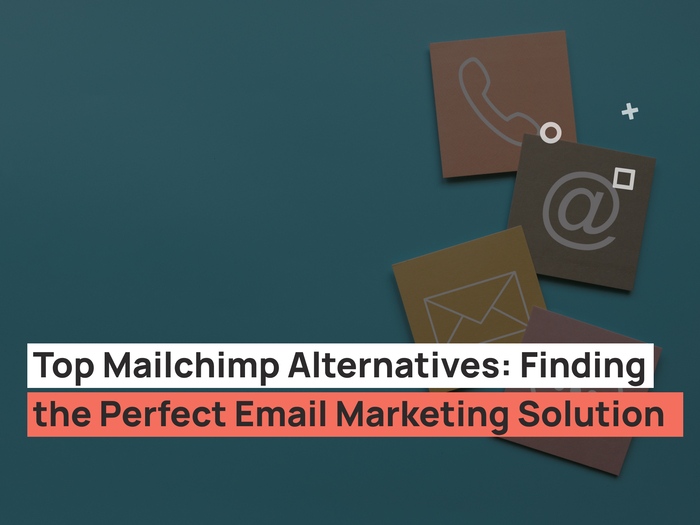The digital marketing space is quickly engulfing the world of business. As a result, consumers are adjusting their ways of obtaining information concerning brands. Many of them are opting for videos to extract details concerning a product or a business. Here are some stats to support this point.
According to Social Media Week, 55% of consumers watch online videos daily. More so, the viewers claim to retain 95% of the message from the videos they watch. This shows that videos in brand marketing or awareness are super useful and entirely efficient.
So, how can your business launch effective video marketing strategies? Are you looking for the best tips and strategies to engage with consumers via video content?
This guide will cover everything you need to know from video content marketing concepts, starting with defining the term. We’ll also share benefits you’ll enjoy from video marketing.
Also, you’ll learn about different types of videos that you can create, and steps to take when creating your video content marketing method.
But first, let’s define video marketing.
What Is Video Marketing?
When looking at video marketing meaning, you ought to think of other marketing tools like brand-based social media posts or online marketing blogs, Facebook, YouTube to mention a few.
Next, convert them into a video. That’s the simplest definition of video marketing. What’s more, video marketing content comes in different forms: case study videos, product demo videos, promotion videos, FAQ videos, or even webinars.

It involves any content in video form you share with the targeted audience either via the email address or other channels to help an organization achieve its marketing goals.
The videos may get tailored to boost sales, create awareness of new changes, maintain your business’s good reputation, or strengthen the business-customer bond to achieve loyalty.
7 Popular Types of Video Marketing
1. Product video
This type of video tells your clients about your product or service. You can show your audience your best sellers’ main features and additional information about the products. The main advantage of this video content is the ability to share with the audience how your product or service works.
Whether you make a short demo video or a film about your brand, what’s important is that you show your products in action. What’s more, product videos work perfectly when put on your landing page. That’s because they offer your audience an initial look at your product.
Based on statistics, having landing page videos can boost conversion rates by more than 80%. Try different landing page formats, add a voiceover, make a screencast, and apply different effects to engage and intrigue your audience.
2. Instructional/Explainer Videos
Use instructional videos to respond to users’ questions while offering explanations of ways to solve their problems.
Additionally, you can use instructions to teach your audience something new. By making video guides, you’ll help your viewers know about your brand, company, or products or service better thus stimulating them to buy.
To start with, video marketers should come up with an instruction scenario. Here write your script and include your visual materials and use screen recording to help make your guide more understandable.
The instruction videos have several formats you can choose such as testimonials, ‘how to’ videos, explanation videos, among others.
3. Webinars
Webinars and live videos have been in use in video marketing content. However, they’re still popular thanks to their effectiveness. Video marketers should remember that people like watching a live video on YouTube that offers them valuable insights.
As you educate your YouTube viewers, offer advice, or are organizing a discussion panel, webinars are a key component of your video content marketing method.
What’s more, YouTube webinars are a great tool for encouraging conversations with thought leaders and internet experts in your industry.
Be sure to promote your videos with paid ads to help get your viewers to participate online. This also allows your audience to ask questions once the discussion has come to a close thus helping them connect with your company.
When it comes to how-to and instructional videos, you may have to create a script and have an executable plan for your webinars.
This is important if you are hosting a forum for discussions or a Q&A session. Be sure to keep your viewers interested and use informal communications that can help hold your viewers’ interest. Some great tools for this are anecdotes and jokes.
4. Vlogs
A video blog (aka Vlog) allows you to create your unique brand voice while delivering an immersive experience to your viewers. These types of videos are a great introduction to your brand since vlogging is among the best formats that allow you to discuss your company culture.
To create a vlog you don’t have to script out everything from start to finish. This shouldn’t be an all-embracing video editing and production process with a professional camera for you to create this type of video. Hey, you could even use your Smartphone for this.
Vlogging can boost your branding campaigns while helping you build a trust-based, yet strong relationship with viewers. You could give an office tour to share your company’s atmosphere, share with viewers about your day at work, or do a short Q&A with a CEO.
That allows your viewers to meet your team members and colleagues. This helps viewers perceive your teams as actual people with interests, personal experience, and character.
5. Behind-the-scenes videos
The backstage videos or behind-the-scenes videos help open your company to viewers and draw them in. Also, they’re an excellent way to help your company stand out from the rest thus attracting new clients.
This type of format can include humorous moments, jokes, after-work events, as well as corporate parties. Additionally, you might even draw in new hires when you shore your office live. This allows you to show how amazing your business culture is and how they’d fit well in.
Again, backstage videos also offer a good appreciation of your business’ working process while sharing how your product or service is created from A to Z. Your viewers get to participate in team meetings and witness how your workmates interact while showing the process followed to deliver your product or services.
6. 360° and Virtual Reality Videos
In the recent past, there has been an increase in interactive 360° and virtual reality videos. A 360-degree video helps visitors investigate parts of the world from all angles. It allows you to turn right and left to observe all the details of your surroundings.
The ability to ‘explore’ places from anywhere in the globe can be very immersive – like you really are standing on Cabo da Roca. Also, there are 360° excursions with a remote-controlled person to guide you through the Faroe Islands.
With VR headsets, then 360° experiences become more accessible. Thanks to augmented and virtual reality technologies, users can today discover brand new worlds thus allowing their imagination to expand. You might decide to visit the cyberpunk future and even wrestle at medieval events.
These unique experiences hook visitors via the first pixel thus helping your company stand out from the competition. Furthermore, the virtual reality world will keep growing, so it may be a good time to take advantage of this type of content marketing approach.
7. Instagram videos
Most people often think that Instagram is a unique platform that lets you increase your customer engagement. Today, we cannot emphasize enough the importance of Instagram presence.
Nearly all brands have an Instagram profile, which makes it the best platform to create an effective pitch for a product or service and sell it.
Research carried out on the Quinty analytics tool shows that Instagram videos attract 21% more user engagement than still photos.
Statistics show that 72% of consumers like learning about any brand, product, or service by watching videos.
As such, you can share different things on your business Instagram feed to increase video views. This includes high-quality videos covering brand history, tips, and tricks, ads from your current campaign, your YouTube channel previews, or office brainstorming sessions.
One key advantage of Instagram is that your audience can like and/or easily share your marketing videos. Using locations and hashtags, along with mentioning experts and bloggers within your posts, helps you attract more buyers.
Note that native advertising gives you an increase by 40% click-through rate compared to other paid promotions. Therefore, if your business is linked to popular topics such as the beauty industry, fashion, and media, then you’ll have to incorporate Instagram into your video marketing plan.
Video Marketing Process Examples
For in-depth knowledge of the videos entailed in video marketing, the following are templates to help you understand better;
Template 1: Product Demo video
A product demo video aims to educate the viewer on how the product works and its benefits. If your business is looking to create a demo video, here is the flow to enhance its effectiveness. Follow the procedure step after step, and your product demo video will provide great quality that it can generate the desired result.
Introduce the problem your product solves
In this section, you begin by briefly introducing the problem your product can solve. Note that the first thing shouldn’t be showcasing your product, not yet. You have to present the pain point of the viewer first.
Provide possible solution
Having introduced the problem your product can solve, you can show the prospect how to solve their pain point. You can go about this by directly telling your viewers that there is a new way to solve the problem effectively.
Reveal your product or service
This stage is for showcasing your product. How it works and how efficient it is over other solutions. It is where you shout out loud the benefits your viewers will get by using your product. Additionally, this is where all the features of your products or services get mentioned clearly.
Examples and testimonials
Here, you show real-world examples of your product in use. You can use a video of positive reviews from a few of your customers.
Testimonials are critical as the prospects typically relate them to what they expect from your business. With testimonials on how your company offers the best services or products, it means that your video will have the upper hand in generating more leads and increasing the conversion rate.
Call to Action
The last step in a product demo video is calling the prospects to action. Here, it would be best to show your viewers what to do next after finishing your video.
You can inform them how to get your product. This section depends on the video’s goal. What were you planning to get from your viewers when creating the video?
Template 2: The how-to video
As the name suggests, this video shows your targeted group how to do something. Although this video is not designed to convert the prospects right there and then, it’s incredible in putting your brand at the forefront for better perception by potential customers.
Here’s a simple procedure for crafting a powerful how-to video;
Introduction
The Introduction part of a how-to video aims at letting the viewers know they are sailing in the right boat. The introduction here doesn’t have to capture the topic’s importance since the viewers are already aware. Also, jump straight to the point to avoid the viewers clicking away.
Tips on how to do something
This is where you explain the procedure you wanted to present to the prospects. Depending on your video, the steps on how to accomplish something get started in this section.
Something to note here: Since you have limited time to engage your viewers, you can opt to cover the basics of each step and move to the next one. Doing so will help you avoid boring your viewers with heaps of content, resulting in them clicking away.
Bottom line
Since you have finished explaining the procedure or steps, it’s time to wrap up or conclude in simple terms. You can end by summarizing what they’ve learned.
It doesn’t necessarily mean you have to repeat the exact things you’ve covered in the body. You can finish with an example not mentioned when outlining the procedure, which summarizes what they’ve learned.
Template 3: Explainer Video
This video marketing video is used to explain complex concepts that put your business in the spotlight. Below is a step-by-step procedure for coming up with a perfect explainer video;
The introduction
When it comes to creating videos for explanatory content, the introduction should be direct to the point — no beating around the bush. Shout out loud what you have for them. Introduce the concepts.
The Questions
In this section of your explainer video, you can ask the common questions people have concerning the concept. Why ask? Asking helps to create curiosity in the viewers, and therefore, they will crave for your next step in the video, which is the explanation.
The explanation
The structure of your explanation in this section entirely depends on the concepts getting explained. Generally, this section shouldn’t be too long or short but just enough to shed light on the idea in question.
The product connection to the concept in question
If you aimed to explain a concept and then link your products or services with it, this is the section to do so. The crucial matter in this part is a perfect transformation from the concept’s clarification to your product.
The transition should be smooth so that it doesn’t feel like an advertisement but rather a part of the explanation.
Steps and Tips to Build a Successful Fan Video Marketing Strategy
Are you looking to come up with the best strategy in video marketing? Then, it’s time to get fully equipped with the ultimate tactics to ensure the video you share hits the audience’s pain point for more conversion rates and improved performance of your business.
When the video marketing share is steered in the right direction, the results will be overwhelming. Your business will get a giant Return on Investment (ROI) so long as the video’s content is mighty sufficient and well projected to the relevant audiences.
Anyway, crafting a successful video marketing plan doesn’t have to be an uphill battle. Follow the simple steps below for a result-assured strategy:
1. Know the video’s goal and the emotional impacts you want to bring out on prospects
When building your digital marketing plan, the first thing to bear in mind is the purpose of creating and sharing the video, plus the emotional impact you want your prospects to have.
For the part of the video’s goal, do you want to increase your brand awareness, or do you intend to inform your audiences about your operation changes?
And as for the emotional impact, do you want your audiences to feel happy or inspired? Or do you want them to laugh? Whatever the goal or the emotional impact, you should have them on your fingertips to craft outrageous video content that is result-structured.
With perfect clarity of the video’s objectives, you can create mind-blowing video content that none of your audiences can resist. On top of that, a goal-oriented video determines the content to include and assists in hitting the prospect’s pain point. You’ll achieve this by introducing your products or services in a way that solves the prospect’s puzzle.
Additionally, with your video’s goal crystal clear, you will know which stage of the marketing funnel is vital to target. Check out the following;
- Awareness – If your viewer is in this stage of the marketing channel, the video should tackle a challenge that opens their eyes to realize they have a problem. As you consider the awareness stage, your video should contain enchantments to grab the audience’s attention and then introduce your brand to them.
- Consideration– In this stage, your audience is aware of their existing problem, and probably, they are digging every corner of the internet for possible solutions. If your target audience is in this stage, the video should engage them to create interest and desire for your products.
- Decision– in this stage, your potential customers have thoroughly researched and have come up with several choices to solve their problems. If your video is aiming at audiences in this stage, it should provide proof to prospects that among all the options they’ve got, your products or services are the perfect matches and that they stand out in the cut-throat competition.
Something else worth noting, if the video is targeting audiences that are already customers, it should aim at delighting or motivating them to keep buying from you – its primary mission should be to establish loyalty.
For the emotion part in mind, you can work on the colors in your video and ensure the scripts you use will pull out the audience’s emotional responses you are aiming for.
2. Identify Your Buyer Persona
Immediately after knowing why you are creating the video and the stage of the marketing funnel you are aiming at, the next step is finding out who your audiences are, which makes the cornerstone of your video marketing solution.
Creating a video without the specific group in mind is setting yourself up for failure. A social media marketing video without a viewership will undoubtedly fail to generate the desired results.
Those meant to watch it on social media platforms like Facebook won’t, while those who will watch will not convert. This stresses the significance of knowing who your target group is.
And how are you supposed to identify your target viewers?
Simple. Use a buyer’s persona. A buyer’s persona is a researched-centered profile that describes who your customers are, how they make their decisions, and where you can reach them.
With this information, it becomes easier to identify the specific audiences for your video content marketing campaigns. Thus, you can tailor your video’s content for optimum conversion efficiency.
3. Set up a video production budget
Like with all essentials of your business, you must be practical when determining your budget and resources. When you have a set budget for your preferred video marketing strategy, it’ll be easy for you to determine the creative resources needed.
Also, consider where you’ll share your videos and the amount of money you’ll invest in your video’s paid advertising.
You could consider starting small and testing a small monthly budget until you’re content with the results. Thereafter, expand from there. The best video marketing budget should give you a promising return. Also, as you continue to add to your budget while testing, you’ll further improve the idea of acceptable and good ROI.
Here are some key elements that you should consider:
- Cameras and any other equipment
- Talent and time to write your script
- Video editing and production time
- Color correction and motion graphics
- Your crew’s labor and experience
4. Determine the type of video to create
Based on the video’s goal and the viewer research, it should be easier to select the kind or category of video you want to create. The classes range from testimonials, how-to videos, product demos, or case studies; the list is long.
Before you create a video, remember to select the most suitable type or category of videos to ensure the generation of desired results. If you find it challenging to select the category appropriate for your business, feel free to learn from the following examples;
As you create a video and want to showcase the mastery of skills in your niche, you may host a live webinar and provide solutions to the industry’s everyday issues.
Similarly, if you want to prove your brand’s credibility, you may use customer testimonials video that points out positive reviews from your customers
To get it right, understand that it’s about the videos’ intent and their possible impacts on the targeted audiences.
5. Choose The Right distribution Platforms
Video marketing has shown to be a major factor in achieving high ROI rates. But this is possible provided they’re distributed on the right channels and using the right Video Marketing strategy.
Also, it’s worth noting that the channel you choose to promote your video marketing approach is crucial in the success level of your video marketing campaigns.
You should understand that it’s not enough for you to record and upload your video on Facebook Instagram Twitter, or YouTube. It should be promoted strategically on different social media platforms like Twitter and Facebook so you can reach your desired audiences.
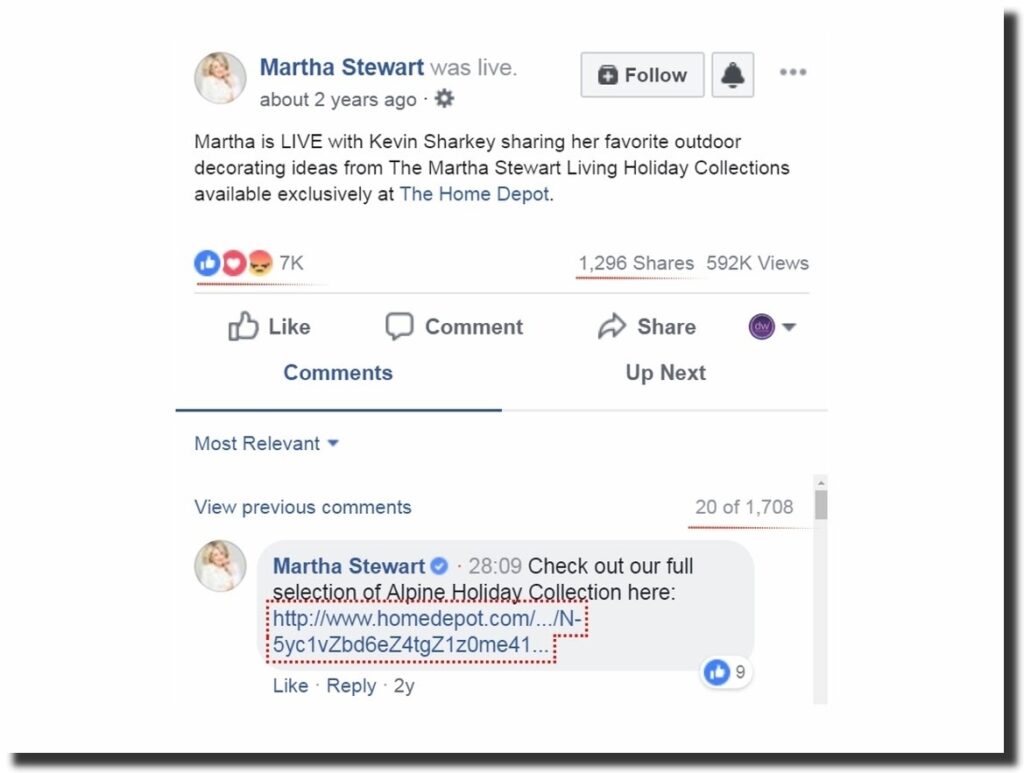
Nonetheless, if your viewers like your videos, they’ll promote and share them for free. Entertaining and relatable video ads are viewed by different people as they tag their friends in the comment sections. Facebook video is a very popular social media platform with a 166 million user base.
Above all, where you promote your video marketing method is an important component. You should therefore decide on the best you can reach your target group with your video ads.
Below are some channels you could decide to use:
- Blog post
- Streaming platforms (Hulu, Netflix, etc.)
- Social media (Facebook, Instagram, Twitter, LinkedIn, YouTube, etc.)
- Google Ads networks
- Sales assets
- Facebook video live
- Your website
- Landing page
- Partner blogs
- Press releases
Also, sharing your video ads on social media platforms like YouTube and Facebook is mainly required. However, the social channels chosen may vary depending on the platforms your audiences are most active.
6. Create valuable and Cost-Effective Marketing Videos
For you to establish yourself with your audiences, then video branding is critical. Therefore, make sure that you use video elements like your brand colors, slogan, and logo in the initial 5 – 10 seconds of all videos, particularly if you’re making video ads
Note that viewers can normally skip video ads or even scroll past them after several seconds on social channels. And this is different from traditional TV video ads and streaming platforms.
As such consider using video SEO optimization to make sure your video content is seen and ranked. Also, note that two video ads may not be enough — you’ll need to share several, as is the case with blog posts in conventional content marketing.
As such, you can decide to use a video-first strategy to achieve even greater video optimization. This approach is about making video content, then turning the content into supporting social media images, emails, blog posts, and so on.
Keep your video goals in mind
Knowing the video’s goal, selecting the right viewers, and determining the category, it’s high time you shoot the video. This is the step where the actual thing happens.
For video production, there are two ways. You can decide to produce it yourself or hire a video marketing agency. You’ll need to invest in the production materials like cameras, microphones, camcorders, and video editing services for the former heavily.
For the latter, you’ll get the full video marketing services from the agency you’ve hired. The production company will have all the necessary tools to make the video creation process a success. However, it would be best to take caution and ensure you employ an agency that guarantees quality video ads.
Pro tips
During the process of video creation, all equipment used should be in its maximum functioning state. Both the audio and video must be flawless to avoid creating distractions that will divert the audience’s attention.
Similarly, the lighting must be ideal, and the video’s ad background should not be distracting. Instead, it should coincide with what’s happening in the video.
Furthermore, when necessary, you may use background music or appropriate beats to enhance your video’s effectiveness.
When appropriate, you should edit your video to enrich it with quality and equip it with the power to compel prospects to do what you want them to.
Remember your lighting
Also, be sure to practice the best lighting practices. Preferably, you should set up simple lighting, like the “three-point lighting.”
- Key light: The main source of lighting.
- Backlight: Offers separation and depth for the background and subject
- Fill light: Eradicate shadows.
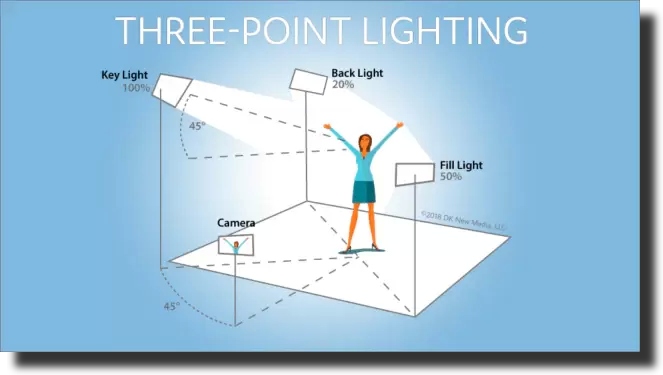
7. Share the video in the most appropriate channels
Now that you’ve come through the whole process and come up with the best video to share with your audience, you ought to be very keen on the channels to share the video.
Marketers know that it’s a waste of resources to develop an excellent video and then post it where your audience can’t find it. Therefore, you should find out the online channel that will reach the targeted audience.
When deciding on the channel, think of the following;
Where can you find your audience?
The platform you’ll use should be where your prospects are active and fully engaged. You can use social media platforms like Twitter and Facebook to get started or post it on your website.
Use any channel appropriate as long as it guarantees that the video ad will reach the targeted audience. With the multiplying number of social media users on channels like Facebook and YouTube, the chances are high that your video ad will reach your audience there.
Sharing the right video ad content on the appropriate platform will fuel engagement metrics and generate more leads for your business.
Producing your video content for your marketing share strategy might seem challenging. But the above guidance should offer you a good starting foundation to use video.
Video Content for Your Marketing Funnel
How video supports each stage of customers’ journey
When creating a roadmap that directs leads to a buyer’s journey, the Video Marketing approach often adopts the Marketing Funnel. The funnel represents the path a given lead is captured then converted into a possible sale.
Also, the Video Marketing Funnel provides you with the necessary help when deciding on the type of video to be promoted and at what time.
Next, let’s explore three main stages of an effective video marketing Funnel.
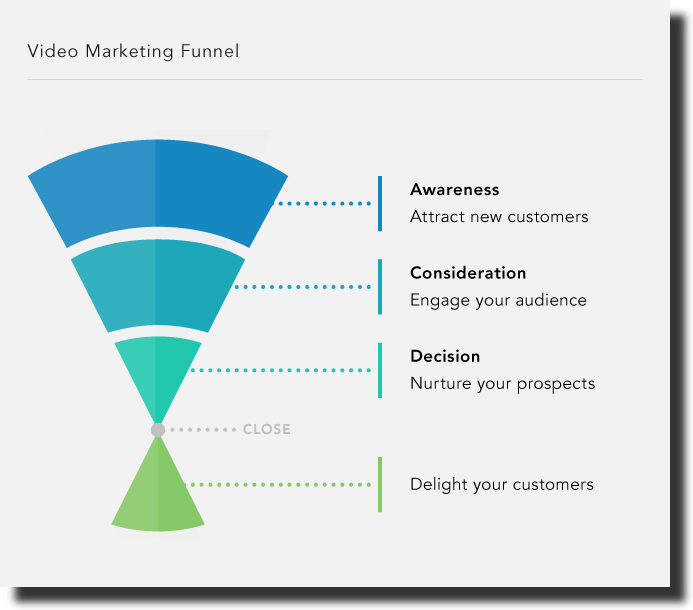
Awareness Phase: Top of the funnel
Are you looking to introduce your product videos or service to more people and start a long-term marketing connection with your clients? Such a goal is what is often referred to as ‘awareness’.
That’s particularly good given that you have a higher value per sale and contract. Also, using videos in the Awareness phase is useful in growing your audience.
As you create an awareness video, the best practices include you setting targets that encourage the discovery of your product and not sales. To ensure success in your marketing endeavors, be sure to look at markers like 3-second views, total views, and view duration.
Consideration Phase: Middle of the funnel
Would you like to strengthen the relationship you have with potential customers while creating interest? If yes, then you should consider using a ‘consideration’ content type of video.
This type of video is worth creating if you find yourself in heated markets and want to build a relationship that’s not founded on discount prices.
Typically, the consideration content is created based on your areas of expertise. Plus this helps showcase your expertise in your field. The Consideration content is particularly useful as you focus on increasing your subscribers on YouTube or even followers on your other social channels.
When creating a consideration video keep in mind that the most significant metric is the click-through rate then followed by visitors’ view length.
The Click-through rate shares the number of people who were engaged enough that they jumped from the video to your website and other content. The secondary metric is the view length that validates your viewers’ level of engagement.
Decision/Conversion Phase: Bottom of the funnel
This marks the last phase leading to closing a sale. Since it’s the last phase of your Video Marketing Funnel implies that buyers know that you’re offering a solution to their problem.
To help nudge clients into finally choosing you over the competition, the best practices will ensure that you develop trustworthy relationships with them. This phase can be done effectively if you display reviews and testimonial videos.
The decision phase is the pointed end of a marketing funnel. It’s when relationship-building pays off. If this is the initial meeting with your customers, then unique selling points or sharp prices are helpful here.
When it comes to your conversion video creation, your most essential metric is more sales. Another important metric you should monitor is the click-through rate.
When you notice that viewers are clicking yet they aren’t buying, it means that there may be a disconnect between the actual products and your marketing strategy.
Choosing the Right Video Hosting Platform
Once you’re ready to experiment with video marketing, everything you need to start is a good camera, microphone, tripod, headphones, and get the proper lighting. These help you create amazing brand videos for your audience.
Popular Video Hosting Platforms
Next, let’s explore some popular hosting channels to help you make the right choice for your brand.
1. YouTube
YouTube is a widely used video hosting platform and today’s second-biggest search engine, after Google. The SEO value potential for optimized videos is one great way that makes YouTube one of the best and extremely attractive.
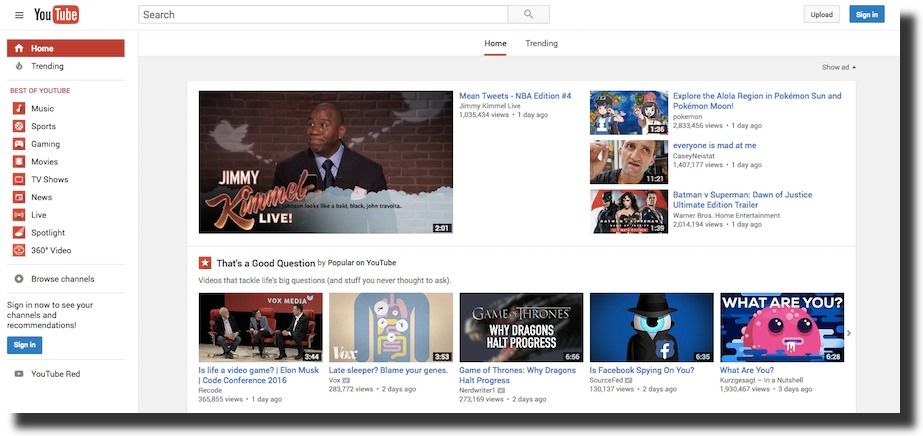
When it comes to general youtube video views analysis, YouTube is fairly easy to use and offers live video and great video editing tools. Plus it reaches a wider target audience and is effective. And this is perfect more so for beginner entrepreneurs.
YouTube offers users a massive stage for your video story which allows you to reach many. However, you have to be proactive and engaged to make sure that your videos don’t get lost among the sea of videos on YouTube.
YouTube video story appears first from Google search results page. Plus it allows you to embed YouTube story videos on your site and landing page. It’s easy for you to share live youtube videos on different social platforms like Facebook.
Plus YouTube provides you with an integrated community so viewers can subscribe to channels to get updates.
2. Instagram
Instagram was intended as a platform for sharing photos and has over time expanded into video.
This platform comes with many pros: to start with, it is free. Also, it’s very user-friendly, which means you don’t need any video experience for you to get started. However, when it comes to video views and length, though it’s longer, it’s restricted to 60 seconds for each video.
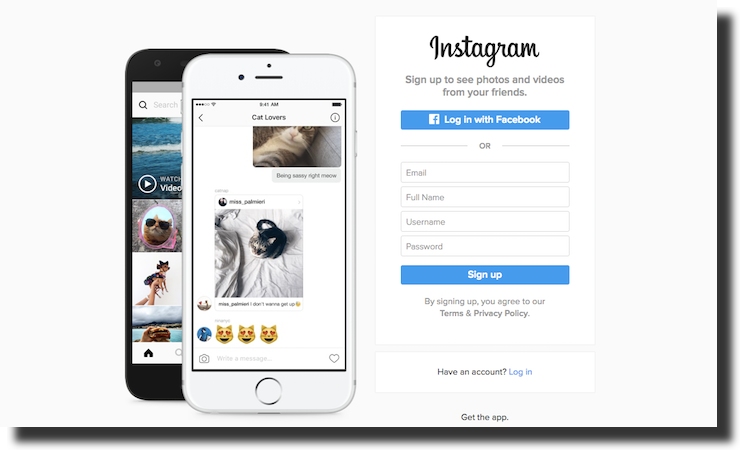
How can you make Gram work for you?
Instagram can be a strong platform alongside YouTube when you’re working on a limited budget. Some new ways you can use Instagram for best results are teasing new products or posting behind-the-scenes videos.
Also, you can use Gram as a great way to show teasers for your full-length videos that you are hosting on other platforms.
3. Vimeo
Vimeo offers paid subscription services however, it’s affordable. Vimeo’s business plan includes 20 video storage gigs a week and starts at $17 a month. Since this platform limits the number of video uploads available, you need to be flexible about when and what you post.
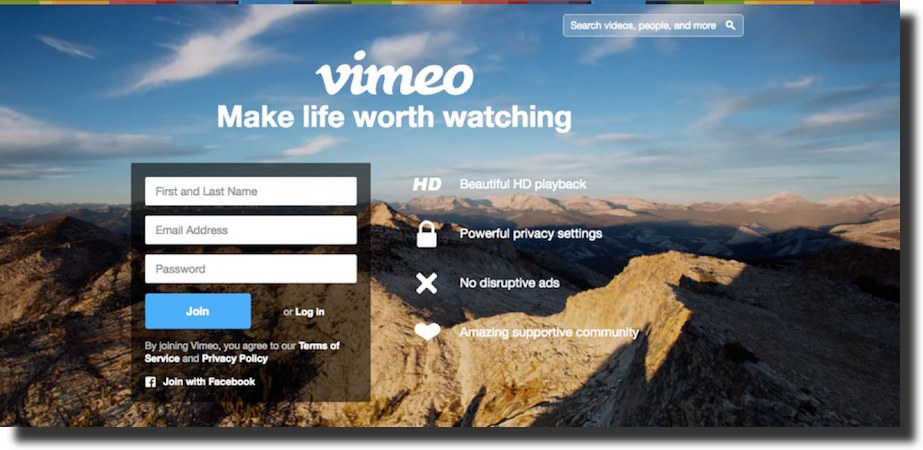
While there’s a cap to the size of videos you can send, we’ve included it here due to its community, personalization, and its powerful analysis tools. Plus it includes good video editing tools.
Also, this platform provides better video delivery compared to YouTube, Facebook, Twitter and other platforms, particularly in full-screen;
While you can use Vimeo Basic for free on this platform, note that it does not come with many features. Plus it provides maximum uploads of up to 500MB per file.
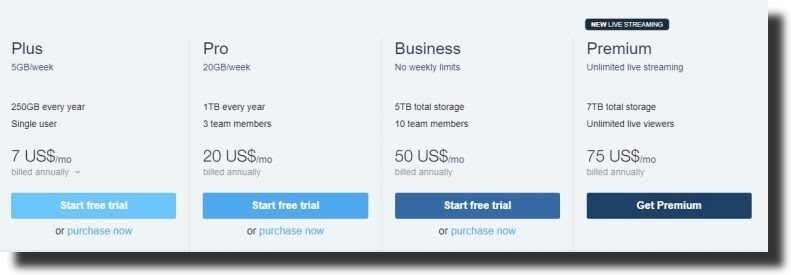
But, when you’d like a better plan, your first investment doesn’t need to be that pricey. For instance, a Vimeo Plus account costs $7/month and gives you 5GB/week.
Also, make sure that you use Vimeo in line with cross-promotion for your videos so your brand can reach a larger viewership possible.
4.Vine
Twitter brings you Vine, a well-known video-sharing app, is focused on short 6 seconds videos.
Vine comes with many positives not to mention its video editing tools. One benefit is that it allows you to create 6-second clips that you can share instantly through different social networks.
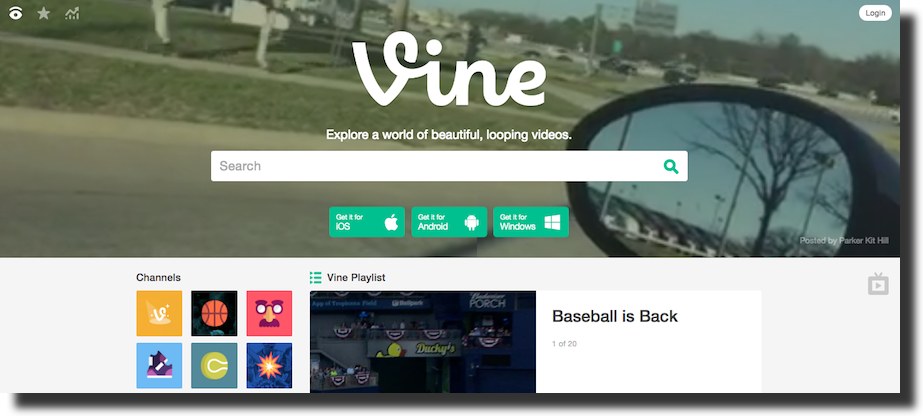
Also, marketers note that vine is a great way you can use to embed videos on our website. For marketers to get the most of Vine then they need to avoid looking at the 6-second limit as a negative. Rather you should use it to focus on captivating your Twitter customers and leave them curious and wanting more.
#5. Brightcove
Brightcove offers you an entire video marketing suite. It’s simple but extremely effective for your enterprise. It lets you create your video player and then embed it on any channel you like.
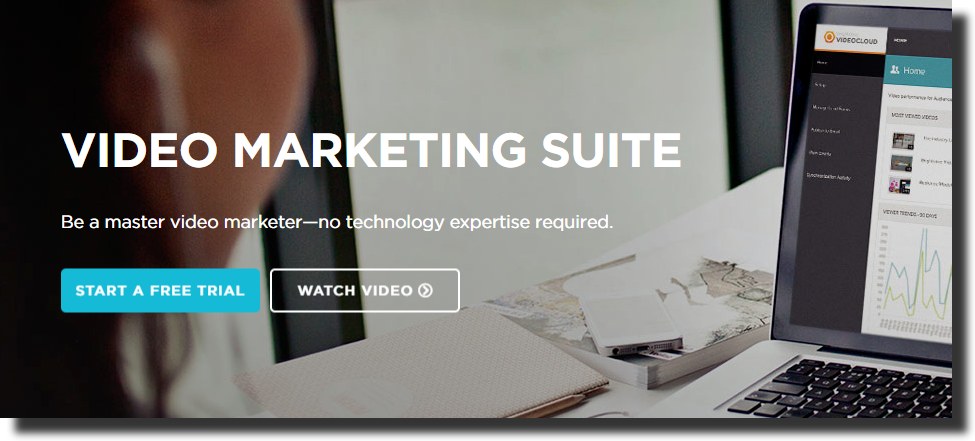
Also, when using their system for your content strategy, Brightcove allows marketers to post videos on several platforms without needing to log manually into them.
With Brightcove, there are fewer things that you need to do outside their systems. That’s because they already provide lots of video-related in-built functionalities.
Top Social Media Video Hosting Channels
Although Vimeo and Youtube are great social media marketing alternatives for longer live broadcasting or pre-recorded story videos, social media marketing lets you connect with your clients more casually.
Facebook Live
Facebook lets you upload video stories whenever it’s ready for easy sharing. Also, similar to youtube, if you’d like live streaming, Facebook Live video allows you to chat with your Facebook followers live within seconds.
To optimize your results with Facebook live, you can create a custom Facebook video description and share a link on your page. With so many people active on Facebook, this is an excellent story hosting video platforms on social media.

Facebook is a well-known social media platform that comes with over 2 billion active users. As such, Facebook videos receive 32 billion views/ day. So that means that as you create Facebook live videos for your digital content marketing strategies, you should not overlook Facebook.
Again, videos can get you better results when using Facebook ads. Thus, you’ll get more engagement and views with lower costs when you use videos for your Facebook marketing plan.
Snapchat
As for Snapchat, the story, opinions, as well as reactions are fairly varied. The Snapchat App was already successful thanks to its feature of photos disappearing. Now Snapchat has become a video content consumption hotspot.

Still the question remains: is the Snapchat platform good for growing your business? 60% percent of Snapchat users are people under 25 years. That makes it a great choice for any brand that wants to engage with the younger audiences.
Also, Snapchat users watch over 10 billion videos/day.
Snapchat became well-known due to its Story feature ( it was created earlier than the Instagram Story feature), and also for comic-picture filters.
If your company caters to a younger audience and uses a playful and fun tone, then Snapchat makes a great communication channel. If not, then Instagram Stories or stories from similar channels may be a good option for you.
Don’t Forget to Experiment with Different Platforms
For you to identify the right platforms to post your campaign marketing, it’s important that you experiment with different platforms. Having one platform may not be enough for your business to get results.
As such, you can post the same video on several platforms, and this can ultimately help marketers decide on the right platforms while reducing your marketing budget.
What’s more, be sure to perform A/B testing for your video campaigns to help boost your overall performance and get better results.
How to Improve the Effectiveness of Your Video Marketing Campaign
If your business employs the best practices, your video marketing strategy will indeed be enhanced to work incredibly. The following are tips and tricks that marketers can use to improve the effectiveness of video marketing;
Keep your videos short
Viewers usually don’t have a lot of time to spend looking at your video. Therefore, your marketers should be as brief as possible. You only have seconds or a few minutes to share the content of your video. Take a look at what experts at HubSpot recommend regarding the video length in the following platforms;
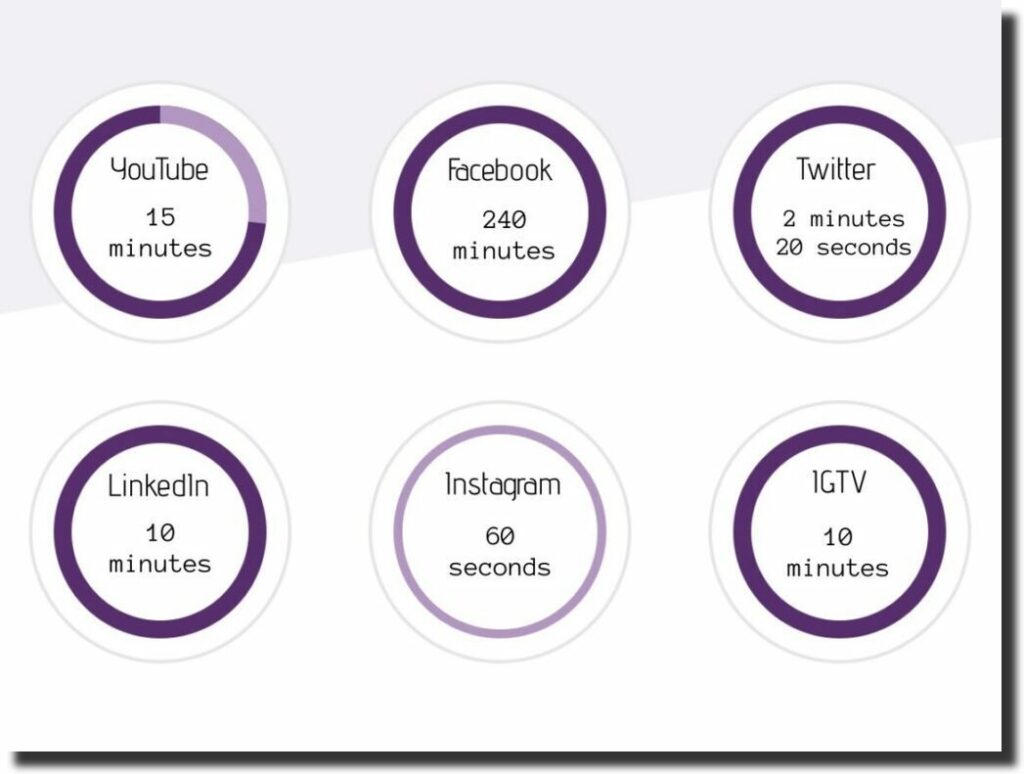
Your video has got a few seconds to appeal to the audience. Hence, the content should be straightforward and direct to the point. At the same time, it should grab the viewer’s attention in an instant—a call to optimize the video length to fit the platform you’ve used.
Use appropriate CTA in the video
The call to action you use in your video can be the difference between getting tremendous results from the video’s intended and total failure. CTA is what moves the audience into doing what the video instructs.
The CTA you use should be keenly thought through to assure that it will generate positive results. For instance, if the video aims to inform viewers of new services you are offering, the video should give an overview of the services and the end and inform the viewers how they can access the services.
Said out clearly, the CTA should tell the audience how to get hold of what your video is about.
Include optimized keywords in your video titles and descriptions
similar to text-based posts; videos require search engine optimization. The audience can easily access the fully optimized video. With an SEO finishing in your marketing video, prospects will easily find it, and therefore, you get the chance to shout out loud whatever you intend to inform them.
Don’t focus on one sharing channel or platform
For your video to go viral and reach many viewers, you can post it on more than one channel. If you have the video in your social media channel like Facebook, Twitter, LinkedIn, or Instagram, you can also send it to your email subscribers and in your blog posts.
The aim of sharing in multiple platforms is to ensure you reap maximum results by generating more leads and increasing the rate of conversions.
Test your video marketing campaign’s performance
How do you analyze your video marketing campaigns’ effectiveness? Or, how do you know where to rectify for your video to generate the results you desire?
Use the analytics to test the result generation of your video marketing campaigns. Analytics are available on almost all platforms you use to share your video.
Detailed video analytics will show you the people watching, the period they stayed engaged, and the point where they clicked away. Equipped with this information, you can engineer your message and bring it out more precisely. This way, you will improve the impact the video has on the audience.
Get Optimizing: Video SEO.
In the SEO world, video plays a unique role. Although your video content isn’t indexed yet by search engines, the metadata attributed to your video is. Therefore, if you’re planning to include video in your SEO strategies make sure you use a combo of both the traditional SEO and new approaches to target video SEO.
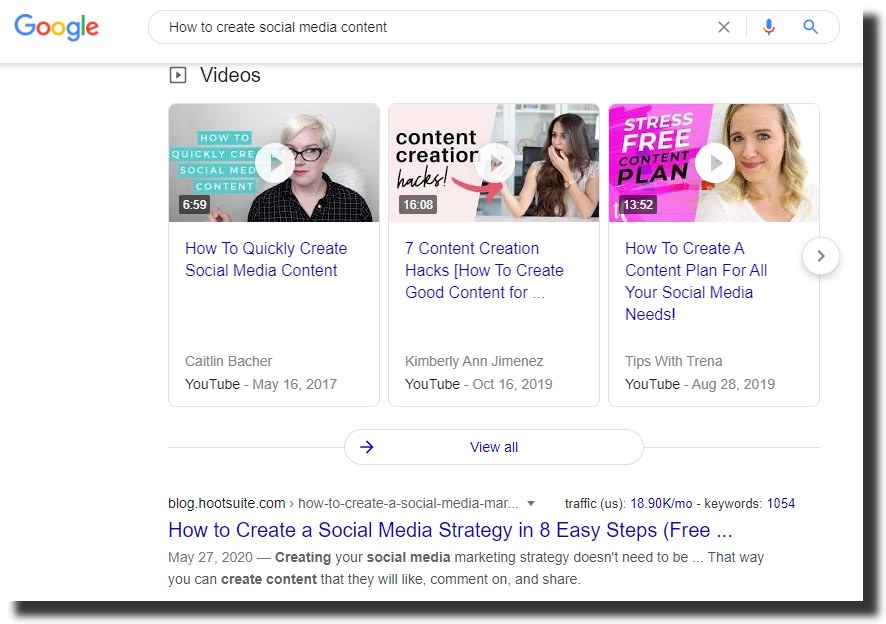
Including a video in your existing SEO campaigns should focus more on understanding how SEO and video work together. As opposed to changing your existing SEO practices altogether.
Note that Video SEO is not a complementary strategy for a thriving business. Rather it’s the direct line leading to a large portion of the existing consumer market.
How can I improve my SEO?
There are numerous technical guidelines you can apply to enhance your website’s SEO. Even then, the best tip is to make sure you provide high-quality video content that informs and educates your viewers. And the most informational and educational form of content is Video.
So, if you’ve created a video, share it with your audience. Normally video is super informative, however, the boost it provides in SEO will have a huge payoff in the end.
1. Embed your videos around quality content
Realize that posting your video on a blank page won’t positively impact your SEO. To optimize your results, make sure you post your video on a page containing content that’s relevant and informative.
This allows search engine crawlers to identify that you not only have engaging multimedia on your website but that you offer lots of useful and valuable information. Even then, make sure that your content relates to the video — on some occasions uploading the video transcript helps a lot, too.
2. Include videos on your site.
When it comes to video, don’t forget to use it on your website. Embed it on any relevant page. If you have, for instance, created a product video, you should consider embedding your video on the homepage, and even on your e-commerce or product pages.
If you’ve published a blog post on your product, be sure to include the video. Also, if you have an FAQ page that has questions about your products, make sure you include your video there, as well.
3. Remember to include the details
SEO optimization covers half technical details and half quality content. And this goes for Video as well. As you post a video on your website, take note of the technical details that help make crawlers indexing your website notice it.
This to consider include tags, titles, description, and even annotations. Fortunately, nearly all hosting platforms allow the video editing of these items.
4. Be consistent – be posting video content regularly
Posting one video is awesome, but posting engaging videos more often is even better. This might not be practical to post videos each day or for each initiative.
However, when you’re running a key campaign that you are working on or even an initiative that will truly benefit from video, then make sure you set aside some resources towards video creation. Also, overlaying text on stock footage may be highly engaging and attract more visitors to your website from organic search.
How You Can Measure Success with Video
You have by now created your video and have incorporated automation, now all you should do is waiting for leads to grow, right? Well, that’s not the case. You may want to monitor your video metrics to measure your success levels and make changes where needed.
As you analyze your video metrics, you may be tempted to focus more on one result over the other. After all, some figures may be more significant to the general marketing goals. However, you need to get the bigger picture of the success level of your video.
For this, you must take a holistic approach when viewing your video metrics. So what things should you look for to tell the effectiveness of your efforts?
Engagement Rate
In the marketing world, engagement has become a huge buzzword. But, it’s a little hard to define it since it is different for different small businesses. As concerns video, engagement can be defined as the percentage of a video that a viewer watched.
Compared to other metrics, engagement rate looks at the real quality of a video’s performance.
Play Rate
How’s the performance of your video on the page it is located? Keeping an eye on your videos’ play rate helps you know the percentage of page visitors who have in fact taken time to click on a video. This is an excellent way you can make sure that you’ve embedded your video on the best and most relevant section of your page.
When you analyze the play rate, it allows you to see whether you need to embed your videos on different parts of your page. Often the best place is the upper half of your web page, or you can use a separate page altogether.
Play Count
Play count is the most essential metric for gauging how a video is performing. This metric shows the sum of total views your video got. It’s also the easiest way you can use to quickly identify how wide an audience a video has reached.
While you may want to have more views as possible, remember that play count is not the finality for your video’s success. Although views are great, realize that it’s even more important that you take note of whether or not a video is truly engaging your viewers.
Heatmaps
Lastly, you’ll need to examine heatmaps. These graphs your viewer’s specific actions when watching a video. Heatmaps let you see at what point your viewers rewatch or drop off your content.
Although engagement graphs indicate how viewers as a whole watched your videos, heatmaps are more specific since they map out how each person watched your video content.
Why You Should Consider Social Media Video Marketing for Your Business
Doing video shouldn’t be a costly, labor-intensive endeavor. Rather, it’s easy for you to make videos with some simple yet inexpensive tools. Now, let’s look at some benefits that video brings to your business. Shall we?
On-site engagement
Using video helps give visitors an improved user experience, which lowers bounce rates. This also increases the time spent on a page. Also, be sure to monitor your metrics. You can make the most of the available free tools for tracking your videos’ ROI (return on investment).
Traffic
If you directly host a video on your site (rather than on a different hosting site for instance YouTube), you’ll be directing traffic to your site rather than to a third-party platform. Better yet, video SEO (search engine optimization) ensures that backlinks direct visitors to your site thus boosting your page ranking.
In-depth analytics
Video offers you comprehensive and clear-cut data that you need to determine how successful this marketing strategy is. With in-depth analytics, you can tell the number of times your videos have been watched. The analytics also give you a better understanding of how viewers are interacting with your content.
Conversion
When you decide to use video marketing, you should establish ways to track the percent of visitors that ultimately convert.
When you use simple strategies like including videos to your landing pages to draw in visitors to your CTA (call to action) or adding annotation links in the videos, you’ll be increasing the chances of visitors following through and ultimately converting.
Video content helps People Retain More Information
Video marketing can be important for you if your business is trying to inform or educate. It’s shown that users tend to retain more of the crucial information provided it’s included in a video compared to text. Therefore, this means your message will register a lot stronger. Plus it will have a longer-lasting impact.
Videos are A Highly Shareable Asset
Videos are more shareable compared to other types of content like PDFs, Slide decks, and audio-based files. Also, people aren’t likely to share any content that requires a higher degree of effort for their connections to consume.
The best way to optimize the network effects is by investing in shorter 2-minute videos. Plus, you can get your message to go viral.
Also, social networks encourage video content thanks to their new features. Again Facebook video has launched Livestage (a video app for teenagers) 3600 Video, and Live Video.
When it comes to Instagram, they’ve set up 60-Second Videos and Instagram Stories. Meanwhile, Twitter offers Periscope. YouTube is so far the second most popular social networking site in the world.
Nonetheless, in the social media context, you should remember that people are sharing emotions and not facts. Also, 76 percent of users state that they’d share branded videos with their friends provided that it was entertaining.
With that in mind, make sure that you create fun and entertaining videos to push for social shares. While emotions aren’t exactly ROI, social shares on the other hand can boost traffic going to your site. Then you can take over from there.
Video content is appealing to Mobile Users
Mobile and video go together. As such, 90% of viewers tend to watch videos from their mobile. Since the 3rd quarter of 2013, watching videos on mobile has increased to over 233%.
Also, YouTube reports that consumption of mobile video increases by 100% each year. Considering that people enjoy watching videos while on the go, there’s an increase in the number of Smartphone users. This also means that your video audience will continue to get bigger and bigger.
Even then, the increase of consuming mobile video means that brands should be receptive to the personal user experience that people enjoy from their smartphones. For instance, offer users better choices of video content that they consume.
Google Loves Videos
Videos help you increase the time visitors spent on your site. That means longer exposure helps build trust while signaling to search engines that your website has good content.
Moovly gives us huge statistics: You have a 53 times higher chance of ranking high on Google if you embed a video on your website. And because Google owns YouTube, there’s been a huge increase in the levels for which videos influence your search engine ranking.
Even then make sure you use SEO to optimize videos you post on YouTube. Be sure to write interesting descriptions and titles. Also, add links back to your products, services, and website. Offer potential buyers a way they can use to take the next step. Again, experiment with interactive videos, to further encourage more actions.
Why Should You Get Strategic For Video Marketing Success
The use of video in marketing is increasing day by day. Thus, businesses have to implement video marketing to reach as many potential buyers as possible. With a complete understanding of what video marketing is, the best strategy at hand, and the benefits it accrues to your business, it’s easier to launch it or restructure the existing one for maximum efficiency.
When used correctly, video marketing can offer you huge benefits. Be sure to consider all the different platforms and even practices that users engage with as you build content for your video content marketing technique.
Also, be sure to experiment with new tools. Note that technology in video marketing is ever-evolving, meaning that tools will keep getting better over time.
Remember that measuring the performance on the different social platforms provides you with valuable information. More so, when you need to establish whether a video is the right type of content for your audience on the different platforms.
Even then, now is the best time to start experimenting with video marketing and establishing what your audience prefers most.
FAQs: Video Marketing
What’s a video marketing approach?
This strategy outlines what you wish to achieve when marketing using videos. This will require that you set some goals for your videos. Be sure to identify your target group on different platforms like Twitter and determine what you’d like to tell them. Also, be both engaging and entertaining enough, plus have a realistic working budget.
Should I incorporate videos on my blog?
Yes. When videos are included in blog posts, it makes them perform well. For instance, blog posts with videos tend to attract nearly three times more linking domains compared to posts that use text only. Sites that link to your website are known as linking domains.
Can I afford video marketing?
Using video marketing doesn’t have to be expensive. Also, the costs might range from high to low. For instance, if working with a minimal budget, you’ll be able to curate relevant videos for your marketing campaigns.
For the higher-end costs, you could hire professionals who’ll create high-quality videos for your business. All in all, the cost of this marketing method will vary between video production companies, depending on different factors.
Where can I start with video marketing?
When using video marketing, your first consideration should be your target market. Determine the demographics of the group you wish to reach. Once you’ve identified your target audience, establish what their interest and likes are.
Look at how you’ll create video content based on their preferences. One good place to start would be by using your buyer personas. They can tell you details you need to know before creating messages that align with your ideal clients. From there, start experimenting with different types of videos, varying messages, and different lengths to identify which formats work best.
How can I improve my video content marketing approach?
As with any other type of marketing, this strategy will improve the more you continue engaging with it. Here are a few tips to help you improve your video marketing strategies:
- Leverage advanced functions and features. Advanced features such as in-video calls, video performance analytics, marketing automation, and call to action, CRMs, and syncing viewer engagement information are today readily available.
- Creating video often. Creating video content more often means that your volume of video story will increase. Also with more videos, your brand will increase consumer satisfaction.
- Experiment and measure your video placement and types. Try-out different video types then evaluate the new distribution channels.
- Track your metrics. Some of the metrics to measure include contribution to sales, views by location, and viewer drop-off rates.
When done right, video is a powerful tool to use in your marketing approach. But avoid creating a video just to have a use video. Ensure that each video contains messages that align with your brand whether you post it on Facebook or Twitter. Your message should be valuable to your viewers as well.



